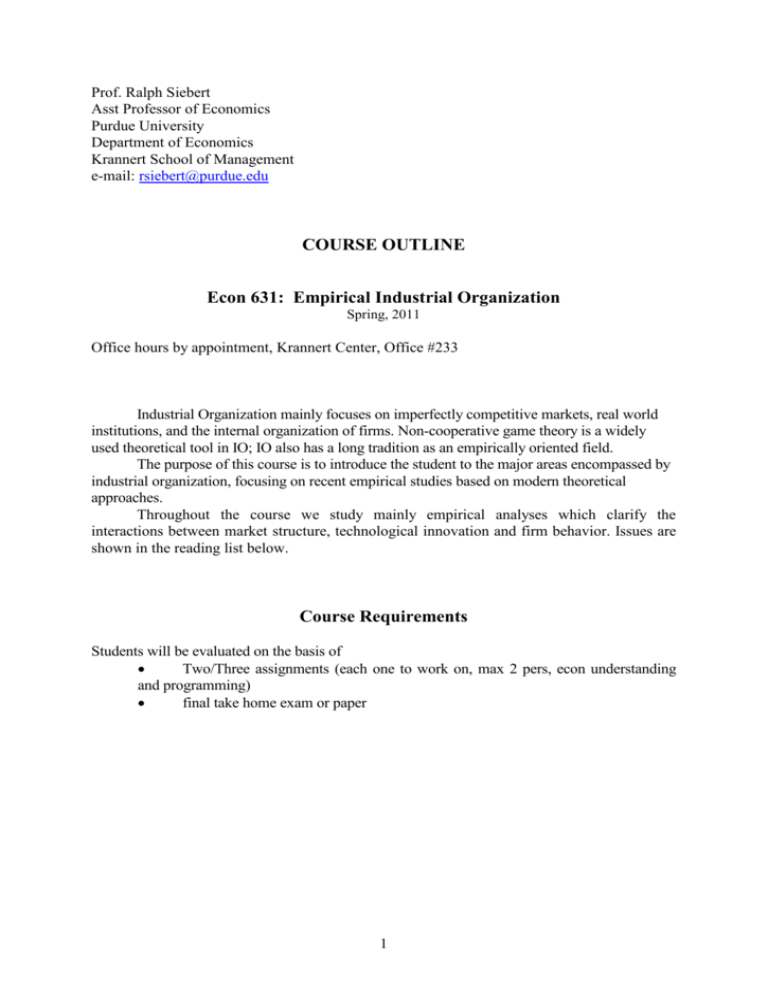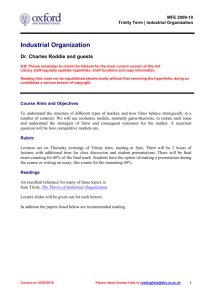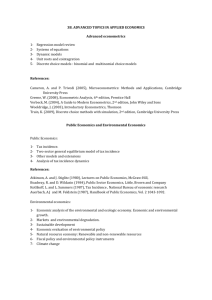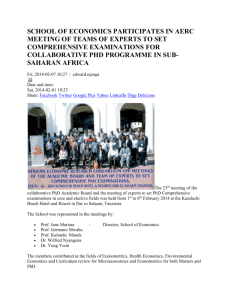Syllabus - Krannert School of Management
advertisement

Prof. Ralph Siebert Asst Professor of Economics Purdue University Department of Economics Krannert School of Management e-mail: rsiebert@purdue.edu COURSE OUTLINE Econ 631: Empirical Industrial Organization Spring, 2011 Office hours by appointment, Krannert Center, Office #233 Industrial Organization mainly focuses on imperfectly competitive markets, real world institutions, and the internal organization of firms. Non-cooperative game theory is a widely used theoretical tool in IO; IO also has a long tradition as an empirically oriented field. The purpose of this course is to introduce the student to the major areas encompassed by industrial organization, focusing on recent empirical studies based on modern theoretical approaches. Throughout the course we study mainly empirical analyses which clarify the interactions between market structure, technological innovation and firm behavior. Issues are shown in the reading list below. Course Requirements Students will be evaluated on the basis of Two/Three assignments (each one to work on, max 2 pers, econ understanding and programming) final take home exam or paper 1 Textbooks We will not use a textbook in this course. However, I recommend some very useful background texts: 1. Berndt, E., 1990, The Practice of Econometrics, Addison-Wesley. 2. Carleton, D.W. and J.M. Perloff, 1994, Modern Industrial Organization, Second Edition, Harper Collins College Publishers. 3. Greene, W., Econometric Analysis, ISBN 0-13-013297-7, Macmillan, New York. 4. Judge, G., R. Hill, W. Griffiths, H. Luetkepohl, and T. Lee, 1988, "Introduction to the Theory and Practice of Econometrics", Wiley. 5. Martin, S., "Advances in Industrial Organization", ISBN 0631217576. 6. Scherer, F.M. and D. Ross, 1990, Industrial Market Structure and Economic Performance, Third Edition, Boston: Houghton Mifflin Company. 7. Shy, O., 1996, Industrial Organization: Theory and Applications, MIT Press. 8. Tirole, J., 1993, The Theory of Industrial Organization, ISBN 0-262-20071-6, MIT Press. 9. Wooldridge, J., Econometric Analysis of Cross Section and Panel Data, ISBN 0262232197. 10. Reiss, P. and F. Wolak, 2003, Structural Econometric Modeling: Rationales and Examples from Industrial Organization, prepared for the Handbook of Econometrics, vol. 5, http://www.stanford.edu/~preiss/makeit.pdf. Lecture 1: Structure/Conduct/Performance Bain, J., 1956, Barriers to Competition, Cambridge, Harvard University Press. Schmalensee, R., 1989, “Interindustry Studies of Structure and Performance” in: Handbook of Industrial Organization, Chapter 16. Scherer, F.M., 1990, Industrial Market Structure and Economic Performance, Houghton Mifflin. Martin, S., 1988, “Market power and/or efficiency?,” Review of Economics and Statistics , 70(2), pp. 331-35. Lecture 2: Gibrat’s Law and Selection (Tobit) Models Simon, H and C. Bonini, 1958, “The Size Distribution of Business Firms,” American Economic Review, vol. 48, no. 4, pp. 607-17. Evans, D., 1987, “Tests of Alternative Theories of Firm Growth,” Journal of Political Economy, vol. 95, no. 4, pp. 657-74. Hall, B., 1987, “The Relationship between Firm Size and Firm Growth in the US Manufacturing Sector,” The Journal of Industrial Economics, pp. 583-606. 2 Mansfield, E., 1962, “Entry, Gibrat’s Law, Innovation, and the Growth of Firms,” American Economic Review, pp. 1023-1051. Lecture 3: Cost Functions (Cobb Douglas and Translog) D. Evans and J. Heckman, 1984, “Multiproduct Cost Function Estimates and Natural Monopoly Tests for the Bell System,” in Breaking up Bell, D. Evans (ed.), North Holland, New York, pp. 253-82. Röller, L.-H., 1990, “Modelling Cost Structure: The Bell System Revisited,” Applied Economics, Vol. 22, No.12, 1661-1674. Baumol, J., J. C. Panzar and R. D. Willig, 1982, Contestable Markets and the Theory of Industry Structure, Harcourt Brace Jovanovich, New York, Chapter 4 and 7. Lectures 4 and 5: Production Functions (Productivity, Simultaneity and Selection Problems) Olley, S., and A. Pakes, 1996, “The Dynamics of Productivity in the Telecommunucations Equipment Industry,” Econometrica, vol. 64, no. 6, pp. 1263-1297. Levinsohn, J., and A. Petrin, 2003, “Estimating Production Functions using Inputs to Control for Unobservables,” Review of Economic Studies, pp. 317343. Wooldridge, J., 2005, “On estimating Firm-level production functions using proxy variables to control for unobservables”. Lecture 6: Supply-Side Structural Models Bresnahan, T., 1989, “Empirical Studies in Industries with Market Power,” in Handbook of Industrial Organization, chapter 17, pp. 1011-1058. Genesove, D. and W.P. Mullin, 1998, “Testing static oligopoly models: conduct and cost in the sugar industry, 1890-1914,” Rand Journal of Economics, Vol. 29, No. 2, pp. 355-377. Borenstein, S. (1989), “Hubs and High Fares: Dominance and Market Power in the U.S. Airline Industry”, RAND Journal of Economics, 2, 344-365. 3 Lecture 7: Identification of Market Power and Semi-Structural Approaches Bresnahan, Timothy F., 1982, “The Oligopoly Solution Concept is Identified,” Economic Letters, 10, pp. 87-92. Lau, L.J., 1982, “On Identifying the Degree of Competitiveness from Industry Price and Output Data,” Economic Letters, 10, pp. 93-99. Panzar, J. and J. Rosse “Testing for Monopoly Equilibrium,” Journal of Industrial Economics, Vol. 35, no. 4, pp. 443-456. Sullivan, D., 1985, “Testing hypotheses about firm behavior in the cigarette industry,” Journal of Political Economy, 93, 586-598. Lecture 8 and 9: Demand-Side Structural Models Bresnahan, Timothy F., 1987, “Competition and Collusion in the American Automobile Industry: The 1955 Price War,” Journal of Industrial Economics, Vol. 35, no. 4, pp. 457-482. Berry, S., 1994, “Estimating Discrete Choice Models of Product Differentiation,” Rand Journal of Economics, vol. 25, no. 2, pp. 242-262. Berry, S., J. Levinsohn, and A. Pakes, 1995, “Automobile Prices in Market Equilibrium,” Econometrica, vol. 63, no. 4, pp. 841-90. Nevo, A., 2000, “A Practitioner's Guide to Estimation of Random-Coefficients Logit Models of Demand,” Journal of Economics & Management Strategy, vol. 9, issue 4, pp. 513-548. Petrin, A. and K. Train, 2005, “Control function corrections for omitted atributes in differentiated product models,” working paper, University of Chicago. Lecture 10: (Static) Entry Models and Sunk Costs Berry, S. and J. Waldfogel, 1999, “Free Entry and Social Inefficiency in Radio Broadcasting,” Rand Journal of Economics, vol. 30, no. 3, pp. 397-420. Berry, S., 1992, “Estimation of a Model of Entry in the Airline Industry,” Econometrica ,60, pp. 889-917. 4 Bresnahan, T. F. and P. C. Reiss (1987). “Do entry conditions vary across markets?” Brookings Papers on Economic Activity 1987 (3, Special Issue On Microeconomics), 833–881. Bresnahan, T. F. and P. C. Reiss (1990), “Entry in monopoly markets,” The Review of Economic Studies, 57 (4), 531–553. Bresnahan, T. and P. Reiss, 1991, “Empirical Models of Discrete Games,” Journal of Econometrics, 48, pp. 57-81. Bresnahan, T. and P. Reiss, 1991, “Entry and Competition in Concentrated markets,” Journal of Political Economy, pp. 977-1009. Sutton, J, 1998, Technology and Market Structure. Cambridge, Massachusetts: MIT Press. Lecture 11: Single Agent Dynamic Models Rust, J., 1987, “Optimal Replacement of GMC Bus Engines: An Empirical Model of Harold Zurcher,” Econometrica, 55, pp. 999-1033. Pakes, A., 1986, “Patents as Options: Some Estimates of the Value of Holding European Patent Stocks”, Econometrica, 54, pp. 755-84. Hotz, V.J. and R. Miller, 1993, “Conditional Choice Probabilities and the Estimation of Dynamic Models,” Review of Economic Studies, 60, pp. 497529. Aguirregabiria, V., and P. Mira, 2002, “Swapping the Nested Fixed Point Algorithm: A Class of Estimators for Discrete Markov Decision Models,” Econometrica, 70, no. 4, pp. 1519-1543. Lecture 12: Multi Agent Dynamic Models Bajari, P., L. Benkard, and J. Levin, 2007, “Estimating Dynamic Models of Imperfect Competition,” Econometrica. Pakes, A., M. Ostrovsky, and S. Berry, 2007, “Simple Estimators for the Parameters of Discrete Dynamic Games,” Rand Journal of Economics. Aguirregabiria, V., and P. Mira, 2007, “Sequential Estimation of Dynamic Discrete Games,” Econometrica. Ericson, R. and A. Pakes, 1995, “Markov Perfect Industry Dynamics: A Framework for Empirical Work,” Review of Economic Studies , Vol. 62, No. 1, pp. 53-82. 5 Pakes, A., and P. McGuire, 1994, “Computing Markov Perfect Nash Equilibrium: Numerical Implications of a Dynamic Differentiated Product Model,” Rand Journal of Economics , pp. 555-589. Stephen R., 2010, “The Costs of Environmental Regulation in a Concentrated Industry,” under revision at Econometrica. Collard-Wexler, A., 2006, “Demand Fluctuations and Plant Turnover in the Ready-Mix Concrete Industry,” under revision. Siebert, R. and C. Zulehner, 2010, “The Impact of Market Demand and Innovation on Market Structure,” under review American Economic Review. Aguirregabiria, V. and Siebert, R., 2010, “A Simple Method to Estimate Dynamic Games.” Lecture 13: Auctions/Strategic Alliances/Innovation Auctions Laffont, J.-J., H. Ossard and Q. Vuong, 1995, “Econometrics of First Price Auctions,” Econometrica, pp. 953-980. Guerre, E., I. Perrigne and Q. Vuong, 2000, “Optimal Nonparametric Estimation of First-Price Auctions,” Econometrica, Econometric Society, Vol. 68, No. 3, pp. 525-574. Bajari, P. and A. Hortasu, 2005, “Are Structural Estimates of Auction Models Reasonable? Evidence from Experimental Data,” mimeo. Cason, T.N., K. Kannan, and R. Siebert, R., 2009, “An Experimental Analysis of the Impact of Information Revelation Policies in Sequential Auctions with Cost Uncertainties,” revise and resubmit Management Science. Strategic Alliances Kamien, M., E. Muller, and I. Zang, 1992, “Research Joint Ventures and R&D Cartels,” American Economic Review, 82, pp. 1293-1306. Röller, L.-H., R. Siebert, and M. Tombak, 2007, “RJVs and Firm Heterogeneities,” Economic Journal. Martin, S., 1996, “R&D Joint Ventures and Tacit Product Market Collusion,” European Journal of Political Economy 11(4), pp. 733-741. Martin, S., 2002, “Spillovers, Appropriability, and R&D,” Journal of Economics 75(1), pp. 1-32. 6 Siebert, R. and K. Gugler, 2007, “Market Power versus Efficiency Effects of Mergers and Research Joint Ventures: Evidence from the Semiconductor Industry,” Review of Economics and Statistics. Siebert, R., 2009, “Jostling for Advantage or Not: Choosing Between Patent Portfolio Races and Ex Ante Licensing (with Georg von Graevenitz),” Journal of Economic Behavior and Organization. Siebert, Ralph, 2010, “The Impact of Ex Ante Licensing on Innovation: Evidence from the Semiconductor Industry”. Lecture 14: Adoption of New Technologies Schmidt-Dengler, P., 2006, “The Timing of New Technology Adoption: The Case of MRI,” mimeo. Liu, A.-H., Siebert, R., and C. Zulehner, 2010, “The Optimal Timing to Adopt New Technologies when Cannibalization Matters”. Genesove, D. 2000, “The Adoption of Offset Presses in the Daily Newspaper Industry in the United States,” CEPR discussion paper. Einav, L., 2010, “Not All Rivals Look Alike: Estimating an Equilibrium Model of The Release Date Timing Game,” Economic Inquiry. Sweeting, A., 2009, “The Strategic Timing of Radio Commercials: An Empirical Analysis Using Multiple Equilibria,” Rand Journal of Economics, 40(4), Winter. May be briefly covered Collusion and Cartels (Bresnahan, deRoos Ellison, Martin, Pakes, Porter, Röller and Steen) Intertemporal Price Discrimination (Cason, Chintagunta, Gowrisankaran) Dynamic Demand (Aguirregabiria, Gowrisankaran, Hendel, Nevo, Rysman) Price Discrimination and Willingness to Pay Nevo, A. and C. Wolfram (2002), “Why Do Manufacturers Issue Coupons? An Empirical Analysis of Breakfast Cereals,” RAND Journal of Economics, 33, 319-339. Busse, M. and M. Rysman. (2005), “Competition and Price Discrimination in Yellow Pages Advertising”, RAND Journal of Economics, 36, 378-390. 7 Siebert, Ralph. “Why do Non-Locals Pay More for Houses?” (with Manish Gupte). Miravete, E., 2003, “Choosing the Wrong Calling Plan? Ignorance and Learning,” American Economic Review, 93, 297-310. Learning by Doing Benkard, L., “A Dynamic Analysis of the Market for Wide-Bodied Commercial Aircraft,” Review of Economic Studies. Siebert, R., 2010, “Learning by Doing and Cannibalization Effects at MultiVintage Firms: Evidence from the Semiconductor Industry,” B.E. Journal of Economic Analysis & Policy. 8









